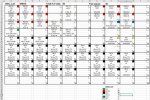Well, upfront, I have a very basic knowledge of excel software and I hope my question isn’t too lame…
Having said that, I have multiple storage boxes which I need to organize. Each box holds 100 units in defined fixed positions (1-100). Units have a very dynamic range of names (#ID) and also a variable number of units will be loaded to each box at a given time, meaning I don’t have a fixed list of #IDs for the units in each box or all boxes together. The unit #ID always comes first in its description (highlighted in yellow in figure 1) in the space I have allocated to each item, followed by other parameters which are not important now.
In figure 1 units at positions 21-23 are all ID: HEK293, the ones in positions 24 and 34 are ID: NSC-34, unit 31 is “CHO” and positions 32 and 33 are empty. The image above is from an excel file I have made to organize these boxes and it was working pretty well when I had only a couple of boxes to organise. Unfortunately, now I not only have a growing number of boxes but also a greater diversity of #IDs to account for.
In order to automate the counting of items/box and the number of empty spaces I have a list under the table I have made (figure 2) which gives me the number of units for each unique #ID. So far I have been typing the list manually, which has not been very practical with too many boxes...
Finally, my question is: How can I automatically list the newly added items to a list of unique values in the same sheet, in order to longer need to type them individually? I mean, if I add now a single unit ID'ed “XXX” at position 91 this would be a new unit never listed before in this sheet, and in my system it will need to be typed in manually. Instead, I want to figure how to make it appear as unique item number “7” in my list (see list underneath the table in figure 2)? I want to be able to automatically list any unique value added to rows “2”, “6”, “10”, “14”, “22”, “26”, “30”, “34” and “38” (as can be seem from figure 2) to the list underneath (starting from P39, or any other given position)
On note, I have searched for “list unique values from a given range of cells” and the solutions I have found didn’t work for me (or I may be using them wrong!)… I get either “N/A” or “0” in the listing cells. Advanced filtering also haven't work for me. I have tried to follow the example on the website below without success.
Excel formula: Extract unique items from a list | Exceljet
BTW, I am using office 2016.
Any help will be greatly appreciated!
Best,
mcastro
Having said that, I have multiple storage boxes which I need to organize. Each box holds 100 units in defined fixed positions (1-100). Units have a very dynamic range of names (#ID) and also a variable number of units will be loaded to each box at a given time, meaning I don’t have a fixed list of #IDs for the units in each box or all boxes together. The unit #ID always comes first in its description (highlighted in yellow in figure 1) in the space I have allocated to each item, followed by other parameters which are not important now.
In figure 1 units at positions 21-23 are all ID: HEK293, the ones in positions 24 and 34 are ID: NSC-34, unit 31 is “CHO” and positions 32 and 33 are empty. The image above is from an excel file I have made to organize these boxes and it was working pretty well when I had only a couple of boxes to organise. Unfortunately, now I not only have a growing number of boxes but also a greater diversity of #IDs to account for.
In order to automate the counting of items/box and the number of empty spaces I have a list under the table I have made (figure 2) which gives me the number of units for each unique #ID. So far I have been typing the list manually, which has not been very practical with too many boxes...
Finally, my question is: How can I automatically list the newly added items to a list of unique values in the same sheet, in order to longer need to type them individually? I mean, if I add now a single unit ID'ed “XXX” at position 91 this would be a new unit never listed before in this sheet, and in my system it will need to be typed in manually. Instead, I want to figure how to make it appear as unique item number “7” in my list (see list underneath the table in figure 2)? I want to be able to automatically list any unique value added to rows “2”, “6”, “10”, “14”, “22”, “26”, “30”, “34” and “38” (as can be seem from figure 2) to the list underneath (starting from P39, or any other given position)
On note, I have searched for “list unique values from a given range of cells” and the solutions I have found didn’t work for me (or I may be using them wrong!)… I get either “N/A” or “0” in the listing cells. Advanced filtering also haven't work for me. I have tried to follow the example on the website below without success.
Excel formula: Extract unique items from a list | Exceljet
BTW, I am using office 2016.
Any help will be greatly appreciated!
Best,
mcastro







